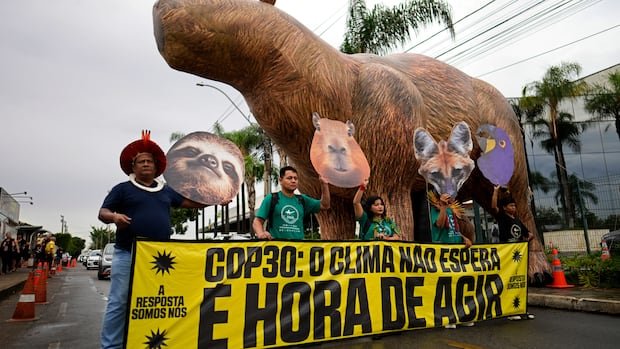All countries of the world had homework this year: submit new-and-improved plans to fight climate change.
But the plans they handed in “have barely moved the needle” on reducing Earth’s future warming, a new United Nations report finds.
And a good chunk of that progress is counteracted by the withdrawal of the United States from the effort, the report adds.
The newest climate-fighting plans — mandated every five years by the 2015 Paris Agreement — shave about 3/10ths of a degree Celsius (nearly 6/10ths of a degree Fahrenheit) off a warming future compared with the projections a year ago. Only one-third of countries that signed the agreement, covering 63 per cent of emissions, submitted new climate plans.
Canada submitted its latest plan in February. It has since been rated “highly insufficient” by the non-profit group Climate Action Tracker.
Earlier this year, Environment and Climate Change Canada forecast an emissions drop of 18 per cent by 2030, far below its target of 40 per cent; and 20 per cent by 2035, far below its target of 50 per cent.
The Institut de l’énergie Trottier at Polytechnique Montreal cited the latest figures in a new report last week that calls for a “co-ordinated policy reset” this year to transition to a net zero energy system.
After hosting her G7 counterparts in Toronto, Environment and Climate Change Minister Julie Dabrusin says Canada has ‘absolutely not’ lost its status as a climate leader after removing key Trudeau-era emissions policies. Dabrusin responds to questions about whether Canada’s 2030 targets are still possible by saying that ‘we always knew they were ambitious,’ and says she and the prime minister have ‘no issues’ despite her website declaring her opposition to oilsands expansion.
Meanwhile, in the U.S., the Trump administration’s policies, which range from rolling back environmental regulations to hindering green energy projects, will add back 1/10th of a degree Celcius of warming, the UN Environment Program’s Emissions Gap report said Tuesday.
“Every 10th of a degree has ramifications on communities, on ecosystems around the world. It is particularly important for those vulnerable communities and ecosystems that are already being impacted,” said Adelle Thomas, vice-chair of a separate UN scientific panel that calculates climate impacts.
“It matters in heat waves. It matters in ocean heat waves and the destruction of coral reefs. It matters long-term when we think about sea level rise.”
Global average temperature increase is mainly caused by the release of greenhouse gases like carbon dioxide, which happens when fuels like oil, gas and coal are burned. So the plans that countries turn in must detail how, and how fast, they will cut emissions of such gases.
Within the next decade, Earth is likely to blow past 1.5 C (2.7 F) of warming since the mid-1800s, which is the internationally agreed-upon goal made in Paris. If countries do as they promise in their plans, the planet will warm 2.3 to 2.5 C (4.1 to 4.5 F), the report calculates.
Current policies put the world on path for 2.8 C (5 F) of warming, providing context for the upcoming UN climate talks in Belem, Brazil.
Even super fast and deep cuts in emissions from coal, oil and natural gas will still more than likely mean global temperatures go up at least 1.7 C (3.1 F) this century with efforts then to bring them back down, the report says.
Ten years ago, before the Paris Agreement, the world was on a path to be about 4 C (7.2 F) warmer.
“We are making progress,” UNEP executive director Inger Andersen told The Associated Press. “We have to go faster.”
The United States — which submitted a climate-fighting plan in 2024 from the Biden administration but now will exit the Paris Agreement in two months — changes the future outlook significantly.
Until the Trump administration decided to get out of the climate-fighting effort, the U.S. plan was promising some of the most significant cuts in future emissions, the report said.
UNEP said the U.S. did not provide comments on the report by their deadline and asked for emissions data about the U.S. to be removed. The UNEP declined but included a footnote at the request of the U.S. saying that it doesn’t support the report.
Now the UN is calculating that the rest of world must cut an additional two billion tonnes a year of carbon dioxide to make up for what the report projects is growing American carbon pollution.
Last year, the world pumped 57.7 billion tonnes of greenhouse gases into the air and needs to get down to about 33 billion a year to have a chance of limiting warming to near the goal, the report said.
U.S. President Donald Trump berated the United Nations on Tuesday, telling fellow world leaders at the National Assembly that predictions about climate change were made by ‘stupid people’ and will cause countries to fail if they don’t get away from this ‘green scam.’
Climate Analytics CEO Bill Hare, who helps run a separate emissions and temperature projecting report called Climate Action Tracker, said that his calculations show the same as the report.
The numbers indicate “a lack of political will,” he said.
Rachel Cleetus, senior policy director with the climate and energy program at the Union of Concerned Scientists, called the report’s findings “alarming, enraging and heart-breaking.”
But she said world leaders still have the power to act decisively to rein in emissions.
“Ambitious climate action can cut energy costs, improve public health and create a myriad of economic opportunities. With alarms blaring, the upcoming UN climate talks must be a turning point in global climate action.”



